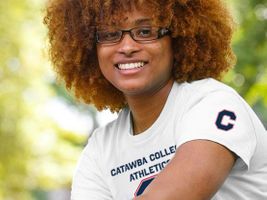Story and Photos by Hannah Davis
Catawba students get instructions for inspecting the trees from Bolin and Schwartzman (Photo: Hannah Davis)
Catawba student Alysia Plafcan inspects an American Chestnut tree protected by a white tube. (Photo: Hannah Davis)
Catawba College students in Dr. Jay Bolin’s resource ecology and management class took a field trip recently to Frog Hollow Orchard, just outside of Salisbury, to learn about the conservation efforts of The American Chestnut Foundation (TACF) on the plight of the American Chestnut tree.
The American Chestnut tree is one of America’s most historic trees, as it used to make up one in every five trees in the Appalachian mountain range. These trees became popular during the turn of the 20th Century in America as they grew fast, straight and tall and were rot-resistant.
The regional science coordinator for TACF, Ed Schwartzman, has been working at Frog Hollow Orchard with the backing of the LandTrust for Central North Carolina and Catawba College. “The American chestnut is an American legacy because of its variety of uses as a food crop and a timber tree,” he said. “It was very important for wildlife and provided abundant mast [fruit/nuts of trees] every year.”
The problems with the tree began with the introduction of the Chinese Chestnut tree in 1904. The introduction of the Chinese Chestnut brought the introduction of a blight called Cryphonectria parasitica to the American Chestnut trees. Most Chinese Chestnut trees are immune to the blight that it brought over, but since the American Chestnut had never been exposed to it before, it was labeled functionally extinct by the 1950s. This is because the blight causes the tree to get cankers or sores on its bark until the tree dies.
Bolin noted that “as a botanist in the mountains of North Carolina, I frequently encounter stump sprouts of American Chestnut and occasionally trees with active chestnut blight cankers, and it's just amazing to consider the completely different structure of many of our forests with the [potential] reintroduction of this important tree.”
The ACF is currently working on the rehabilitation of the American Chestnut tree with chapters in each state where American Chestnuts used to run rampant. “Restoration of the American Chestnut to our forests will be a conservation achievement of historic proportions,” Schwartzman said.
They use cross-breeding techniques with Chinese Chestnut trees in the hope that the gene which gives the Chinese Chestnut some blight resistance will cross over into the American Chestnut genes. After these trees are cross-bred, they are placed into breeding orchards and seed orchards for experimentation. During this experiment phase Schwartzman says, “All trees are inoculated with blight to see which ones survive, and then [we] carry them forward in the breeding program,” and the process starts all over again with special attention paid to the trees that did survive. This kind of experimentation is called a progeny test.
The job of the Catawba students on this trip was to analyze the 625 trees planted two years ago in Frog Hollow Orchard to determine survival. Each student pairing was responsible for two of the 25 plots. “I am excited to have our students engaged in this this project, and to know that we are on the cusp of restoring this tree to its historic role in the ecology of our eastern forests is gratifying,” Bolin said.
“But the chestnut blight isn’t the only problem we have here,” Schwartzman told students before they began their work. Most of the trees were also susceptible to Pytophthora cinnamomi, or root rot, and the field was also full of weeds, which could have caused issues for some of the trees’ growth.
For the ACF and for many botanists like Bolin, saving the American Chestnut is more than just bringing back an old tree; it would be the revival of a historic American staple.
The Center for the Environment was founded in 1996 to educate the college community and the public about environmental stewardship and sustainability, provide value-added education for students through interaction with thought leaders and opportunities for experiential learning, and bring diverse people and groups together to catalyze sustainable solutions to our most persistent environmental challenges. For more information, visit www.CenterForTheEnvironment.org.
